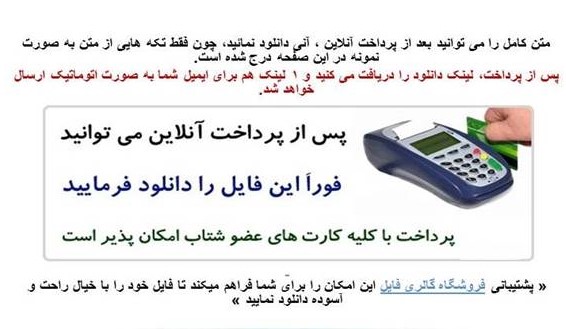

267 صفحه pdf شامل 12 فصل
Solar Power for Your Home
McGraw Hill
2010
David S. Findley
جزییات سرفصلهای مطالب این کتاب
The History of Solar Energy
Sunlight and Life on Earth
The Human Factor
The Future
Food Production and Declining Natural Resources
Desertification
Solar for Humanity
The Benefits and Detriments of Solar Energy
The Solar Power Convergence
Types of Solar Power
Other Forms of Energy
Wind Power
Geothermal Energy
Tidal Energy
Ultimate Benefits of Solar Energy
Challenges of Solar Energy
Types of Solar Energy
Energy and Oil
Passive Solar
Concentrated Solar Power
CSP with Parabolic Mirrors
Stirling Engine
Solar Water Heaters
Updraft Solar
Concentrating PV Solar
Types and Benefits of PV Solar
Thin-Film Solar
Focused-Lens and Specialty PV
Solar Costs
Energy-Efficient Home Systems
Remove and Replace Appliances
Washing Machines
Clothes Dryers
Small Appliances
Hot Water Heaters
Solar Water Heater
Tankless Water Heater
Heat Pump
Gas Condensing Hot Water Heater
High-Efficiency Gas Storage Water Heater
Cooling Systems
Room Air Conditioners
Central Air Conditioning
Heating Systems
Geothermal Energy vs. Ground Geothermal
Maintaining Home Heating and Cooling Systems
What to Look For in a New Heating System
Other Large Energy Consumers
Zero-Cost Passive Solar
Passive Solar Homes
The Big and Small Pictures
Building a Passive Solar Home
Passive Solar Home Modifications
Good Solar Design
Types of Solar Gain
Simple Improvements for Solar Gain
Landscaping
Fun with Passive Solar
Solar Oven
Solar Clothes Dryer
Solar Water Purification
Passive Solar Cooling
Gardening
Creating a Personal Energy Plan
Creating a Home Energy Plan
Evaluating Your Home Energy Use
How to Use the Plan
What to Include in a Complete Energy Plan
Making the Most of Your Plan by Changing Old Habits
The Fundamentals of a PV System
PV System Components
How PV Cells Work
Solar Cells and Panels
Single, or Monocrystalline, Silicon Panels
Polycrystalline, or Multicrystalline, Silicon Panels
Amorphous Silicon or Thin-Film Panels
Group III and V Technologies
Building-Integrated Photovoltaic
Concentrated Solar Power
High-Efficiency Multijunction Devices
Solar Panel Efficiency
The Inverter
Electrical Meters
Solar Tracking System
PV Energy Production and Savings
How Much Does a Typical PV System Cost?
Rebate and Deduction Caveats
Warranties and Replacement Costs
Payback Time
Solar Projects You Can Use Today
Solar-Powered Swimming Pool
Solar Lighting
Solar Pet Home
Flexible Solar-Powered Gear
Solar Oven
Electric Lawnmower
Solar Carport
The Real Costs of Energy Consumption
Global Warming
CO2, You, and the World
Reduce Your Carbon Footprint
How and When to Hire a Contractor
Planning Your Solar Renovation
Hire an Architect
Know Your Budget
Choose the Right Contractor
Interviewing Contractors
Things to Notice During the Interview
Licensing
Getting Estimates
Building Contracts
Payments
Permits
What to Do If Things Go Bad
Funding Your Solar Project
Savings
And Loans
Bank Loans
Contractor Loans
Credit Cards
FHA and HUD Loans
State-Funded Loans
Home Equity Loans
Mortgage Refinancing
Rebates, Tax Incentives, and Tax Credits
Tax Rebates
Tax Credits
Grants
Selling Power Back to the Grid
The Future of Solar Energy
Thin-Film Solar
Micro Solar
Nano Solar
Light-Spectrum Technologies
Hybrid Technologies
Electrical Grid
Hydrogen Fuel Cells
Battery Backup
Storage Systems
The Promise of the Future
Appendix: Standards, Conversions, and Green References
Index
Solar Power for Your Home-McGraw Hill



